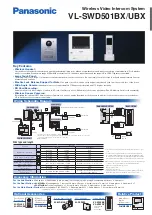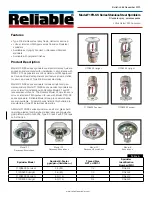
TECHNICAL DATA
ESFR UPRIGHT SPRINKLER
SIN VK520 (K14.0)
Page 3 of 5
Form No. F_060298 19.11.15 Rev 19.2
The Viking Corporation, 210 N Industrial Park Drive, Hastings MI 49058
Telephone: 269-945-9501 Technical Services: 877-384-5464 Fax: 269-818-1680 Email: [email protected]
Visit the Viking website for the latest edition of this technical data page: www.vikinggroupinc.com
G. System design must be based on ESFR design guidelines described in applicable FM Global Loss Prevention Data Sheets,
the National Fire Protection Association, and the Authorities Having Jurisdiction.
NOTE: Viking recommends installing one
style of sprinklers (either pendent or upright) throughout ESFR systems. However, provided the fusible elements
are installed within the distance below the ceiling allowed by the installation standards, and when acceptable to the
Authority Having Jurisdiction, Viking considers the practice of mixing upright and pendent ESFR sprinklers to be ac
-
ceptable.
5. OPERATION
During fire conditions, the heat-sensitive fusible element assembly disengages, releasing the seat and spring assemblies to open
the waterway. Water flowing through the sprinkler orifice strikes the sprinkler deflector, forming a uniform spray pattern to suppress
the fire.
6. INSPECTIONS, TESTS AND MAINTENANCE
A. The sprinklers must be inspected on a regular basis for corrosion, mechanical damage, obstructions, paint, etc. The frequency
of inspections may vary due to corrosive atmosphere, water supplies, and activity around the device.
B. Sprinklers that have been painted or mechanically damaged must be replaced immediately. Sprinklers showing signs of cor-
rosion shall be tested and/or replaced immediately as required. Installation standards require sprinklers to be tested and, if
necessary, replaced after a specified term of service. For Viking ESFR Upright Sprinklers, refer to the Installation Standards (e.g.,
NFPA 25) and the Authorities Having Jurisdiction for the specified period of time after which testing and/or replacement is required.
Sprinklers that have operated cannot be reassembled or reused, but must be replaced. When replacing sprinklers, use only
new sprinklers.
C. The sprinkler discharge pattern is critical for proper fire protection. Therefore, nothing should be hung from, attached to, or
otherwise obstruct the discharge pattern. All obstructions must be immediately removed or, if necessary, additional sprinklers
installed.
D. When replacing existing sprinklers, the system must be removed from service. Refer to the appropriate system description and/
or valve instructions. Prior to removing the system from service, notify all Authorities Having Jurisdiction. Consideration should
be given to employment of a fire patrol in the affected area.
1. Remove the system from service, drain all water, and relieve all pressure on the piping.
2. Using the special sprinkler wrench, remove the old sprinkler and install the new unit. Care must be taken to ensure that the
replacement sprinkler is the proper model and style, with the correct orifice size, temperature rating, and response charac-
teristics. A fully stocked spare sprinkler cabinet should be provided for this purpose.
3. Place the system back in service and secure all valves. Check the replaced sprinklers and repair all leaks.
E. Sprinkler systems that have been subject to a fire must be returned to service as soon as possible. The entire system must
be inspected for damage and repaired or replaced as necessary. Sprinklers that have been exposed to corrosive products of
combustion, but have not operated, should be replaced. Refer to the Authorities Having Jurisdiction for minimum replacement
requirements.
7. AVAILABILITY
The Viking Model VK520 Sprinkler is available through a network of domestic and international distributors. See The Viking
Corporation web site for the closest distributor or contact The Viking Corporation.
8. GUARANTEE
For details of warranty, refer to Viking’s current list price schedule or contact Viking directly.
NOTICE
The owner is responsible for maintaining the fire protection system and devices in proper operating condition. For
minimum maintenance and inspection requirements, refer to the NFPA standard that describes care and maintenance
of sprinkler systems. In addition, the Authorities Having Jurisdiction may have additional maintenance, testing, and
inspection requirements that must be followed.























